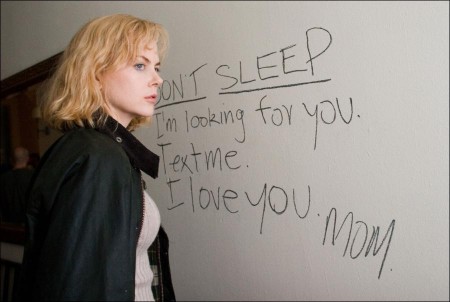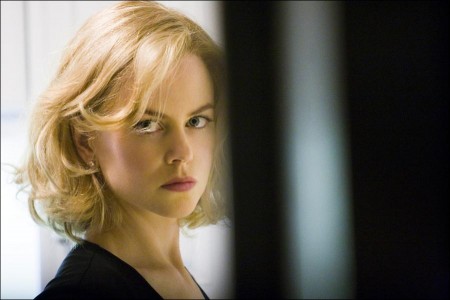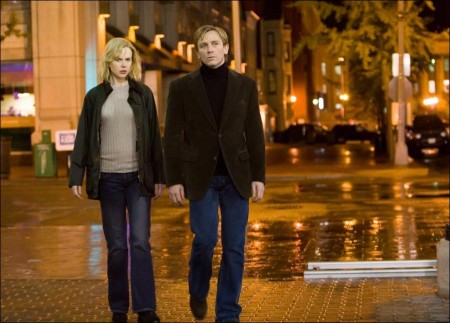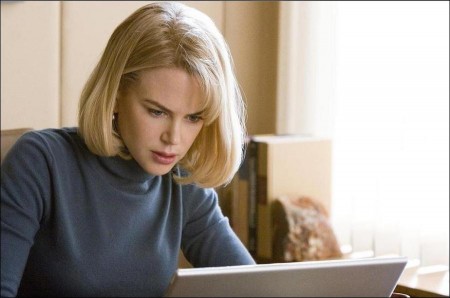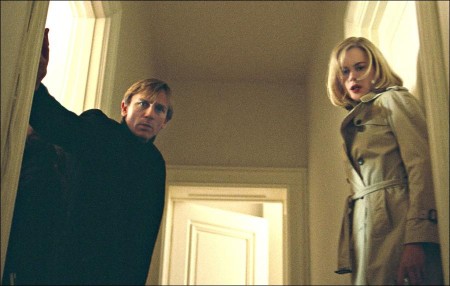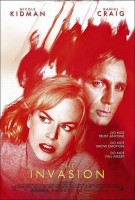Tagline: Do not trust anyone. Do not show emotion. Do not fall asleep.
A massive explosion lights up the skies from Dallas to Washington, DC, shattering the space shuttle Patriot into pieces that rain down across the U.S. The authorities are quick to seize control of the situation, but stories emerge about a strange substance found clinging to the wreckage — something that withstood the extreme cold of space and searing heat of reentry to get here. And the first to come in contact with it are the first to change… But no one wants to start a panic.
DC psychiatrist Carol Bennell does not connect what happened to the shuttle with the bizarre occurrences that seem to accelerate around her: one of her patients is terrified that her husband has been replaced by a stranger; violent outbursts on the streets are quickly subdued; and a very strange substance comes home in her son Oliver’s Halloween candy—something that might, in fact, be alive. She tells her friend and fellow doctor, Ben Driscoll, that something is very wrong despite the fact that Washington does not seem concerned. The official word is that it’s simply a new form of flu, but before realizing the weight of what’s happening Carol lets Oliver spend the weekend with his estranged dad, a high-level official with the Center for Disease Control, who is in Washington investigating the crash and was one of the first people on the scene.
As the epidemic spreads, Carol discovers that the very people in charge of inoculation against it are spreading something far worse—a spore of unknown origin that attacks human DNA while the host sleeps, remaking it in the image of a lifeform that looks like us and talks like us, but with all human emotion drained away. Seemingly overnight, the people around her are transformed into hive-like beings with one imperative: to infect others and take control. Doing everything in her power to stay awake, Carol embarks on a desperate journey into a changed world to stay alive long enough to find her son. To hide among them, she will have to remain calm…betray no emotion…and, most of all, not fall asleep.
Imagine A World
“For me to imagine a world where every crisis did not result in new atrocities, where every newspaper was not filled with war and violence, that is to imagine a world where human beings cease to be human.”
Since it was published in 1955, Jack Finney’s classic novel The Body Snatchers has become regarded as one of the most resonant examples of the power of science fiction to explore social and political paradigms of a given era. In 1956, the first film adaptation provided subtextual commentary on the so-called “Red Scare” that was gripping the nation; while the 1978 remake, released in the wake of the Vietnam war and Watergate scandal, echoed the fears of a population that had ceased to trust its leaders.
This latest adaptation, says Silver, puts a marked twist in the very notion of alien invasion, touching on contemporary cultural issues stemming from fear of pandemic to social and political unrest. “The film poses the idea that an invasion can occur without ships, without the physical presence of aliens. We’re at a time now in which the notion of a pandemic is a real and present threat. What if our destruction could come not at the hands of invaders but through the introduction of microbes? What’s scariest is being confronted by something that could just creep in and take over without anyone knowing until it’s almost too late.”
In a contemporary world, what happens when the people charged with protecting the public are the first to be changed? “If you sense something is wrong but the government, the news, the scientist in charge of stopping a disease…everyone is telling you everything’s okay, people tend to think it’s just paranoia,” says Silver. “That’s how power can slip away – power to stop it or warn people on a mass scale. The main characters in this story have to learn to trust what they’re seeing with their own eyes before it goes past the point of doing anything about it.”
“The Invasion” is a thriller that unfolds through the eyes of a Washington, DC psychiatrist, Carol Bennell, a woman whose child is taken from her at the moment in which the world changes almost overnight. “To me, the crux of the story is this woman’s journey in relation to her child,” says Academy Award winner Nicole Kidman, who stars as Carol. “That’s the thing that interested me. The rush of adrenalin that comes in the desire to save this person that you’ve given birth to—this person you love more than anything in the world—ignites these emotions that otherwise we have no access to. I have two children, so I understand the protection and unconditional love that are attached to those small people.”
Screenwriter David Kajganich notes, “In the Finney novel the alien presence simply wants to survive. But survival takes different forms. You just have to look around our world today to see that power inspires nothing more than the desire to retain it and to eliminate anything that threatens it. It’s no accident that the vehicle for this invasion lands at the nation’s seat of power in Washington, DC.”
“‘The Invasion’ is a thriller that unfolds in a world that is very recognizable world of today,” says producer Joel Silver. “In an era of enormous political, social and environmental paranoia, it really felt for us that now was the right time to make this film. David Kasganich wrote an original screenplay that takes a fresh approach to the ideas in the novel. This movie is thrilling and exciting but with a deeper layer of undertones.”
To bring to life a totally contemporary and realistic take on the story, Silver brought in acclaimed German director Oliver Hirschbiegel, fresh off the multiple award-winning film “Downfall,” his intimate and unsettling portrait of Hitler’s final days. “‘Downfall’ just blew me away,” says the producer. “He brought such intensity, claustrophobia and intimacy to that particular moment in history without losing the incredible realism of his vision. Oliver has a creative need to have things be as authentic as they possibly can, and that’s what we wanted to capture with this science fiction thriller—the sense that it is happening before your eyes in a world you recognize.”
Director Oliver Hirschbiegel offers that, even when dealing with a science fiction story, realism is key for him. “When in doubt, I try to imagine how it would be in real life. I try to avoid any phony, over-the-top filmmaker effects.”
Kidman, who has worked in front of the lens for such diverse filmmakers as Lars von Trier, Baz Luhrmann, Jane Campion and the late Stanley Kubrick, relished the opportunity to work with Hirschbiegel on his first American film after the success of “Downfall.” “I love the way Oliver shoots spontaneously,” she comments. “He’s very much performance-driven. He loves women, too. When you’re working with a man who wants to understand the psychology of a woman—the things she feels, the things that make her rich and wise—that’s what fascinates him.”
“No one touches my child”
Against the broad backdrop of an insidious invasion is an intimate story of a handful of characters brought together by creeping suspicions that manifest themselves in very real, terrifying ways—starting with Carol Bennell, so named as a nod to the book’s main character, Miles Bennell. Kidman plays the DC-area psychiatrist who finds herself in the eye of the storm when one of her patients expresses fear that “her husband is no longer her husband.”
Actress Veronica Cartwright, who appeared in the 1978 classic “Invasion of the Body Snatchers,” plays Carol’s troubled patient, Wendy Lenk, who believes her husband’s entire persona has changed. “Carol does not associate what her patient tells her with the shuttle crash,” notes Silver. “No one, least of all a psychiatrist, would jump to the conclusion of an alien infection when someone fears that a person they know and love has changed. Instead, she looks to the tools of her profession. Is this delusion? In real terms, the truth is so unthinkable that what’s actually happening doesn’t occur to anyone until it’s too late.”
For Hirschbiegel, the character of Carol is the lens through which the story is told. “Everything is centered around her, seen from her perspective. Nicole brought so much of herself to this role in terms of her strength and her absolutely primal need to protect her child,” the director states. “Her ability to immerse herself in the world of the story was fascinating to observe and capture on film. Her reactions felt very natural, which really heightened the urgency of her character’s situation.”
As Carol looks into her patient’s fears, she discovers that similar fears are popping up all over the country. Could it be a mass delusion, or a very real phenomenon tied somehow to the space shuttle crash? Carol shares her suspicions with her closest friend, Ben Driscoll, a doctor at a busy DC hospital. Ben is played by Daniel Craig, who acknowledges, “It’s a platonic relationship, but of course he’s madly in love with her. He wants to take care of her. He sees her going through a messy situation with her ex-husband and their son, and he’s not pushing it, but his dream would be to be with her.”
“I felt so fortunate to have Daniel in the role of Ben,” Hirschbiegel remarks. “He naturally conveyed all the facets of his character: all the toughness, the intelligence and the tenderness that makes you see why Carol relies on Ben so much. Daniel also has a wicked sense of humor. I had a great time working with him.”
Working for the first time with Kidman, Craig was equally impressed with his co-star’s dual propensities for the seriousness of the role and the ability to have fun on set. “She’s a fantastic actress,” he says. “She’s just got so much depth; for me, it was a joy working with her.”
Kidman is likewise appreciative of her co-star. “Daniel is such a fine actor,” she says. “He has an enormous amount of talent. You want to have people around you who inspire you and who are so good at what they do, because then it’s fun to come to work every day. The thing that I just love are those moments between action and cut when anything can happen—to be able to get lost in those moments and lost in the scenes. It’s what draws me back time and time again.”
All you have to do is nothing
Coinciding with the weekend of the shuttle crash, Carol has been contacted out of the blue by her estranged husband, Tucker, played by Jeremy Northam. An official with the Centers for Disease Control (CDC), Tucker is brought to Washington, DC, to investigate the residue on the space shuttle debris and becomes one of the first to be infected by it. His sudden desire to exercise his rarely used visitation rights with his and Carol’s son, Oliver, seems uncharacteristic of him and gets Carol’s guard up. “There is a history between them that is not exactly pleasant, so that colors our knowledge of Tucker right from the start,” says Northam. “He is a senior official at CDC, which has taken him to Atlanta for a long time and now he’s back in Washington. The fact that in the midst of all this he’s so anxious to see his son is worrisome to his ex-wife, and of course he has ulterior motives.
Whatever contagion the shuttle carried to Earth is rapidly spreading as those who are infected are driven to infect others. “Snatchers don’t kill people,” comments Hirschbiegel. “They radically change them from the inside once they’re infected. They transform regular people into something else.”
“You get infected and then the process is completed when you fall asleep,” adds Craig. “When you go into REM (Rapid Eye Movement) sleep, that’s the catalyst which creates this change that takes over your whole body on a DNA level.”
The CDC mounts an emergency national inoculation plan to combat what it names to be a powerful flu, but the truth of the serum is the reverse of inoculation. “In one scene, Tucker is lecturing government officials about this virus and the need to fight it but in reality he’s using the meeting to infect everyone in the room,” explains Silver. “They organize this magnificent campaign, and soon the number of Snatchers grows exponentially.”
“When you’ve been snatched, you look a little better, a little healthier, stronger,” Hirschbiegel describes. “It messes around with your genetic code. Snatchers like order—not like robots, but they don’t respond to anything emotionally. They go into a serene, weird state.”
Seemingly overnight, the colorful, chaotic everyday world is transformed into a muted world of organization, starting first with the keepers of order. “The Snatchers are not dumb,” adds David Kajganich. “The first people they infect are the people who will be most useful to them in their campaign. So, they infect people who are in high-ranking positions in government, law enforcement and commerce to pave the way for a smooth, quick invasion of the rest of us. Efficiency is a big word for describing how Snatchers behave—in the most efficient way possible.”
Increasingly surrounded by people who want to change her into one of them, Carol has only one urgent objective: to save her son, who is now with his father for the weekend and who Carol now realizes is in terrible danger.
Playing her son, Oliver, is a young actor named Jackson Bond, making his feature film debut. “He’s just a darling,” comments Kidman. “He’s the sweetest, kindest boy. He has these elements of being a man, and then he has these childlike responses to things. So, he’s this wonderful mix. And he has great parents, and you can see the work they’ve put in. We got very, very lucky in casting him because he has never made a film before.”
Oliver is unique in that while he does go to sleep after being infected, he does not change. “He is immune from this infection and somehow holds the key to finding a cure,” explains Jackson Bond. But to avoid detection, Oliver and his mother have to attempt to pass themselves off as Snatchers. “You can’t show any emotions because then they’ll figure out that you’re not one and start chasing you,” he says. “So, you’re trying to pretend to be one but you’re still really scared and don’t know what to do.”
Oliver’s immunity to the alien contagion is a crucial discovery to the team of scientists working frantically to find a cure. Jeffrey Wright plays Ben’s friend and colleague, Dr. Stephen Galeano, who has been researching the growing epidemic since Carol and Ben first brought him a sample of the mysterious alien substance.
Safely sequestered, Galeano has been interfacing with other scientists working underground to find a way to fight its insidious effects. Daniel Craig offers, “From the moment he first encounters the sickness, he looks at it on a molecular level, and he jumps to the right conclusion that it’s not from this planet. So Galeano represents hope against this seemingly unstoppable invasion.”
While Kajganich adapted the story for the screen, he did not imagine how brutal it would be when brought to life by the cast. “One of the main characters of the film is infected in broad daylight in a suburban home,” he recalls, “and to me, it was a much more disturbing scene than graphic screen violence. Watching the actors play that out, I had to look away. I couldn’t believe it was as upsetting as it was. You feel the human weight of what’s going on because the cast is comprised of such brilliant actors; it’s incredibly raw and real. You’re watching it happen before your eyes and you start to believe it, even when standing on a movie set.”
Silver says he could not have asked for a more perfect cast to bring the personal fears of the characters to palpable life. “Everyone did a fantastic job with this material. All the players worked together under Oliver’s direction to create a creepy, uncomfortable feeling of this invasion, starting with Nicole, who is in nearly every shot of the film and really anchors the story with her emotional presence.”
Kidman’s character experiences the invasion from the point of view of a psychiatrist, so the actress consulted with professionals to explore the processes a psychiatrist would go through. “My father is a psychologist, so I grew up with that,” she explains. “But it was so interesting to sit down with a female psychiatrist who was based in New York. She was very helpful, I think, just in terms of body language and the way in which you deal with particularly extreme emotions. But obviously, the film isn’t about the therapy sessions.”
People are dying
To help build the world of “The Invasion,” acclaimed production designer Jack Fisk collaborated with director Hirschbiegel and found the German director’s focus on realism refreshing. “Although he was working on a major studio film, he operated pretty much as a European or documentary filmmaker,” Fisk remarks. “The idea was to go to locations, alter them and shoot quickly with minimal lighting. Oliver is used to thinking on his feet and leaving avenues open for exploration, so we quickly adapted to providing him with anything he needed on the spur of the moment.” Fisk adds that “Oliver’s dedication to his perceived reality came to define the locations for the film.”
“‘Downfall’ was so deftly and economically shot,” comments Jeremy Northam. “There is no waste. Oliver knows when to leave the camera and when to move it. It was so interesting working with him.”
One of the predominant visual motifs of the film was the gradual leak of color from the world as the Snatchers gained dominance. “The Snatchers are not as attracted to color as the humans and so color—or the lack thereof—was one way to tell them apart,” Fisk describes.
Hirschbiegel and Fisk collaborated with Oscar-nominated costume designer Jacqueline West (“Quills”) to bring that motif into the wardrobe design. “Oliver is greatly responsible for the Snatcher look,” notes West. “From the first meeting, he said, ‘How do you see these Snatchers?’ I imagined that as they are drained of everything human, they would also be drained of color, personality, and individualism. Their clothes are monochromatic and utilitarian. Their color palette is gray, brown and navy blue but all solid. It’s pretty much a new order.
By contrast, Kidman’s character retains her individuality throughout the film. “Oliver loves classicism and Nicole brings a very classic, timeless look to the character,” West says. “She looks so simple and sleek.”
“When people come in and help you make the character, be it your hairdresser, makeup artist or costume designer, everyone contributes to the performance,” says Kidman. “I think it’s exciting when that happens because it’s not about one person. A performance is about the contribution of everyone in the group.”
Don’t go to sleep. I’m looking for you
Hirschbiegel’s dedication to authenticity came to define the locations for the film. Rather than fabricate a set on a soundstage, he sought to shoot the film primarily in practical locations, preferably the story’s true locations.
Principal photography on “The Invasion” began in Baltimore’s Downtown / Inner Harbor area, which portrayed itself as well as doubling on occasion for Washington, DC. The company then moved to the nation’s capital, the film’s primary setting. Production utilized locations and landmarks recognized worldwide, including the National Mall, George Washington University Hospital in the city’s Foggy Bottom district, the Cleveland Park Metro Station, Georgetown, and the historic Union Station.
Shooting in Washington gave Daniel Craig a particular thrill: “Driving down Pennsylvania Avenue with the Capitol in front of me, with six cop cars behind me and with my lights on was fun,” he remembers. “I was suddenly going, ‘This is fantastic!’”
The footage gathered on the National Mall was augmented by additional footage shot on a private wheat farm that became the space shuttle “Patriot” crash site where the CDC’s Tucker Kaufman arrives to investigate. The site was adjacent to the Fort Howard VA Medical Center. “On this bigger crash site, we built one wing of the shuttle and plowed it into a trench so that only parts of it stuck out,” says Fisk.
For the last six days of DC filming, the cast and crew set up in the residence of the Ambassador of Chile located near Sheridan Circle along the district’s famed Embassy Row on Massachusetts Avenue. The ambassador’s historically significant three-story mansion—designed in 1909 by prestigious architect Nathan Wyeth, who also designed the West Wing of the White House, including the Oval Office—portrays the Czech Embassy in the film.
Though many of the DC locations were tricky, Fisk and location manager Todd Christensen found that the project itself and the people associated with it helped enormously with securing them. “I think that we got an entrée to a lot of great locations because of Oliver’s and Nicole’s involvement,” Fisk notes. “It turned this film into something that people wanted to be a part of. The U.S. Park Service in Washington was incredibly helpful to us. They do so many events in Washington and were very receptive to our ideas. There were restrictions, of course—like how long we were on the Mall—but it was all very workable, and overall it was extremely smooth.”
Following Washington, DC, the cast and crew moved back to Baltimore for the final four weeks of filming, where locations included the Towers of Harbor Court, Baltimore Hospital, the Convention Center, the Legg Mason Building, and the Molecular Biology Department of Johns Hopkins University’s Mudd Hall, the central building of the University’s three-part biology complex. As the location contained active labs with living organisms, the crew was instructed to not enter any room or touch any lab item, which was fitting for the story’s themes.
One of the film’s pivotal scenes was filmed on the roof helipad of the Baltimore Police Department Headquarters, in a sequence that involved a Black Hawk helicopter and picture copters, piloted by veteran movie helicopter pilots Ben Skorstad (“Air Force One”) and David Paris (“Black Hawk Down”).
“We were very fortunate because the United States Army allowed us to utilize one of their actual Special Forces helicopters along with the services of one of their pilots,” Silver remembers. “There were obviously a lot of logistics involved, but we were so grateful for the assistance of the military in making it possible to have a Black Hawk land on police headquarters in the middle of Baltimore, which, I must say, was pretty spectacular.”
Production notes provided by Warner Bros. Pictures
The Invasion
Starring: Nicole Kidman, Daniel Craig, Jeremy Northam, Malin Akerman, Jackson Bond, Jeffrey Wright
Directed by: Oliver Hirschbiegel
Screenplay by: Dave Kajganich
Release Date: August 17th, 2007
MPAA Rating: PG-13 for violence, disturbing content and terror.
Studio: Warner Bros. Pictures
Box Office Totals
Domestic: $15,074,191 (37.5%)
Foreign: $25,096,367 (62.5%)
Total: $40,170,558 (Worldwide)
